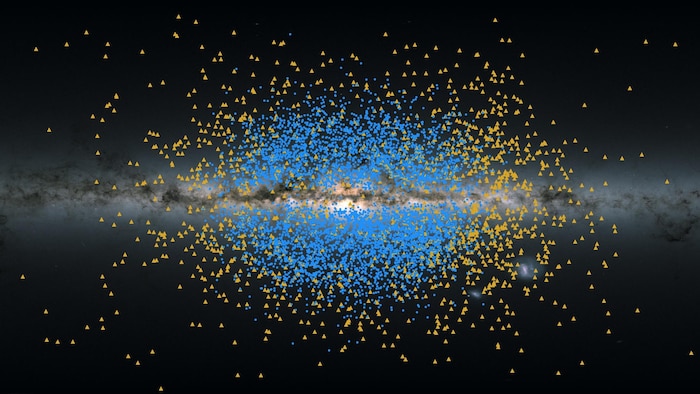
Illustration showing the band that forms the Milky Way. The yellow dots indicate the location of the Shakti stream stars. The blue dots indicate the location of the Shiva current stars.
Agence France-Presse
The Gaia space telescope, intended for mapping the Milky Way, has detected two groups of primitive stars in the heart of our galaxy which are at the origin of its formation more than 12 billion years ago ;years, according to a study published in The Astrophysical Journal (New window) (in English).
These two streams of ordered rotating stars, each containing the mass of 10 million suns, are similar to the first building blocks of the ancient heart of the Milky Way, where the first stars were born before the galaxy grew into its current spiral shape, Khyati Malhan of the Max Planck Institute for Astrophysics in Germany told AFP.
This is the first time that we have managed to identify fragments of this protogalaxy, called Shakti and Shiva, from the name of the Hindu gods whose union gave birth to the cosmos, details the main author of the study.
The ESA (European Space Agency) Gaia probe, which operates at 1.5 million kilometers of the Earth for 10 years, delivered in 2022 a 3D map of the positions and movements of more than 1.8 billion stars.
This map made it possible to identify a population of stars nicknamed poor old hearts, due to their old age – linked to low metallicity (a chemical indicator of the age of a star) – and their central location.
Loading
Princess Kate Middleton suffers from cancer
ELSE ON NEWS: Princess Kate Middleton suffers from cancerLoading
Princess Kate Middleton suffers from cancer
ELSEWHERE IN NEWS: Princess Kate Middleton suffers from cancer
It was an important step for galactic archaeology, which aims to reconstruct the different epochs in the history of the Milky Way in the same way that archaeologists would reconstruct the history of a city, explains the Max Planck Institute in a press release.
The model of the evolution of the Milky Way thus assumes an old central city surrounded by more recent neighborhoods, according to the institute.
But the further back in time and space we go, the more the picture of galactic history becomes blurred, underlines Khyati Malhan.
Astronomers therefore investigated this archaic core identified in 2022. They took a sample of 6 million stars, and studied their chemistry and their position using artificial intelligence in particular. p>
And thus put their finger on two stellar currents, Shakti and Shiva, formed between 12 and 13 billion years ago, in the earliest ages of the Milky Way.
Surprise, their stars have an abnormally high metallicity for such a great age. This is a likely sign that they come from an earlier generation of stars. As they died, the latter released the chemical elements which seeded the interstellar gas from which the stars of Shakti and Shiva came.
Shedding light on the #x27;childhood of our galaxy is one of Gaia's missions, and it is in the process of achieving it, welcomes Timo Prusti, scientific manager of the project at ESA. Even if it will be difficult to find the original embryo of the Milky Way, adds Khyati Malhan.

